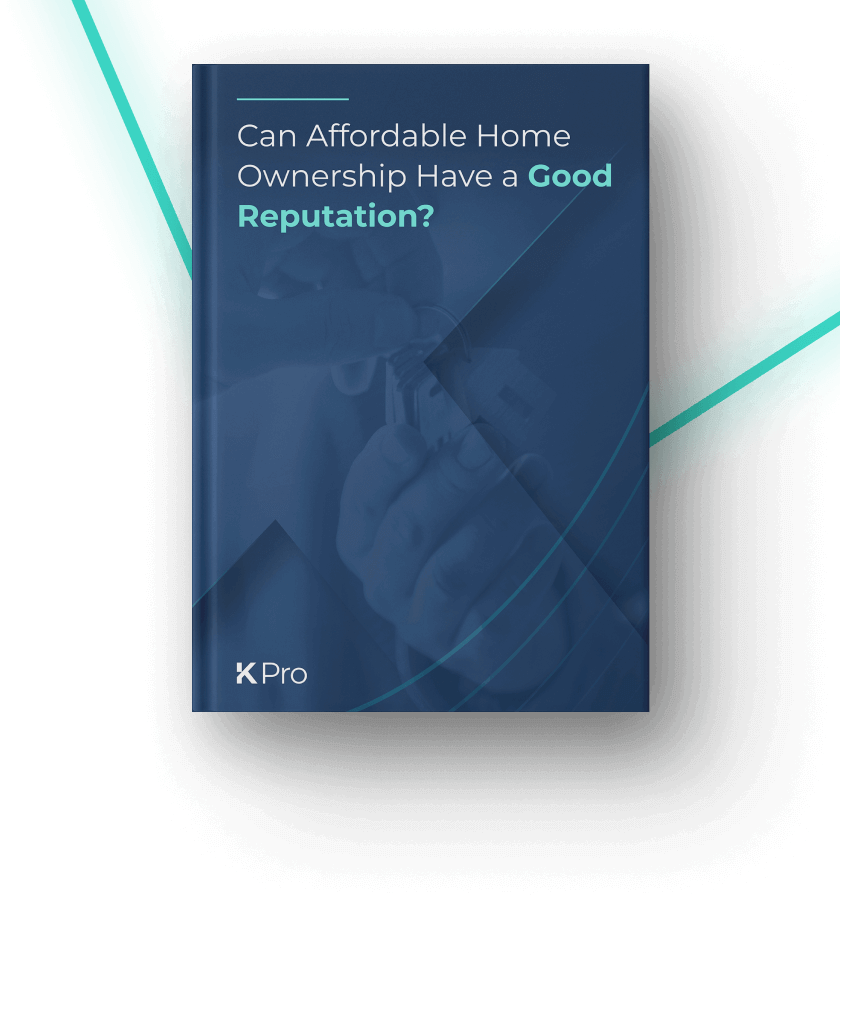
How Technology is Improving the Affordable Housing Market
In a world of rapid technological change, the housing market has traditionally been slow to adapt. In recent years, however, the commercial housing market has adopted new digital tools that have modernised the marketing, sales and lettings process.
Meanwhile, a new generation of tech-savvy homeowners and tenants are entering the market for the first time – and they expect the same seamless digital experiences that are standard in other sectors. According to a Zillow survey:
- 40% of millennials are now comfortable buying homes online
- Digital tools look set to replace physical viewings in the coming years.1

But the affordable housing market has been slower to adapt, with technological adoption lagging behind the private market. This is partly due to the complexities inherent in affordable housing schemes. And customers notice. The technological gap between the affordable and private market means a customer experience gap too, stifling affordable housing providers’ potential leads and revenue generation. But with new digital technologies tailored to the unique needs of affordable housing, the market is changing.
With new technology improving the marketing, sales and letting process, affordable housing providers are able to streamline processes, enhance customer experience and generate more revenue through improved access to shared ownership schemes.
In this article, we’ll explore how this technological shift is giving the wider affordable housing market a much-needed boost, helping providers improve their strategy, increase revenue and reinvest – to deliver for customers across the board.
Suggested reading: If you want to learn more about how the affordable housing market compares to the commercial market, check out our new eBook — Can Affordable Housing Have a Good Reputation?
Modernising affordable housing’s sales and marketing processes
Traditionally, the private housing market has benefitted from digital tools that have been unavailable — and unsuited — to the affordable housing market. These tools often don’t work for affordable housing due to its unique requirements, while third-party providers have been slow to develop solutions. As a result, technological progress has been slow. Outdated tools have become the norm, affecting how providers follow up on leads, and impacting their ability to generate revenue.
But a new generation of technological tools have been built to provide fast and reliable solutions tailored to the unique needs of affordable housing. These include:
1. One-click listings
Affordable housing providers can now list properties with one click across multiple listing platforms, simplifying workflows and maximising market reach — and ending the need to input complex information on each individual platform. While this has long existed in the commercial market, the unique requirements of affordable housing software have made this too complex. Now, listing information like staircase percentages, affordability criteria and minimum share projections can be listed and updated with a click.
2. Lead centralisation and automation
Once listed, lead centralisation tools enable providers to collate leads from across the multiple sites they’ve listed on – in a single, centralised place. They can save purchase histories and communications with homeowners, simplifying how information is stored and accessed. This allows for efficient and timely communication throughout the customer lifecycle. Lead centralisation tools can:
- Integrate with your CRM (more on this later)
- Be API compatible with the property platforms you use
- Collate leads together through advanced search features and automatically update lead information
- Unlike estate agency tools, support the complexities of affordable housing properties, including ownership percentages.
Once leads have been centralised, automated lead management tools systems enable providers to streamline marketing and communications processes. Email automation helps providers nurture leads with tailored marketing campaigns. This maximises the value gained from lead centralisation, improves customer experience and helps convert leads.
3. CRM integration
To maximise the potential of the lead automation, management, and listing tools, they need to be able to integrate with providers’ CRMs. Estate agency tools are often not the best CRMs for affordable housing. But new affordable housing-specific integration tools, however, are enabling integration with listing and lead management tools — or, in some cases, are the same tool. Integration with information in your CRM allows tools to communicate easily, while providing providers with clear visibility over their information. This integration can happen in two main ways:
- Modular: where slotting in where needed to help existing tools work together
- End-to-end: integrating property listing, lead collection and CRM processes in a single place, unifying sales and letting processes.
By reducing the complexity involved in finding and applying for affordable housing, these changes mean a more streamlined, efficient and better customer experience. Short-term, fewer people drop out of the process. Long-term, the reputation of affordable housing increases alongside revenue. With increased revenue, providers can increase market share, allowing reinvestment in customer relationships – and in housing stock.
Want to improve the service you provide your customers? Check out out latest eBook Can Affordable Housing Have a Good Reputation?
Increased efficiency generates revenue and enables reinvestment
The benefits provided by new affordable housing software help revolutionise back-end efficiency. By centralising and automating operations, resources that were previously being used are freed up and can be reallocated elsewhere. By increasing efficiency across the board, new revenue that is generated by these efficiencies is reinvested. The changes provide benefits in numerous areas.
More shared ownership
Shared ownership is the main revenue-generating for housing associations. Improved sales and letting services, leading to improved customer experiences, present housing providers with a great opportunity: to gain more customers and increase revenue.
This allows providers to expand their shared ownership position, creating a feedback loop of improved customer service, increased revenues and expansion of shared ownership. All in pursuit of the providers’ main goal: helping more people to find the right homes.
Reinvestment
Using tools that provide efficiency gains allows newly freed up revenue and resources to be deployed elsewhere. Coupled with greater revenue from an expanded shared ownership position, increased revenue means providers are able to reinvest. In addition to shared ownership, providers can reinvest in social or council housing stock, while upgrading overall customer experience. This creates a reinvestment feedback loop where greater demand leads to greater supply and improved services, which in turn leads to greater demand – and so on.
Better strategic decision-making
New tools allow providers to see the status of their developments and leads in real-time, providing an improved view of internal metrics. Strategic decisions will be better informed, both:
- Short term: Providers are able to see what resources are available, what’s working and what’s not, enabling them to shift resources, like staff distribution, tactically for quick gains
- Long term: Increased visibility over trends might alter providers’ longer-term building priorities, while greater visibility over the customer journey allows for more targeted deployment of customer service and marketing teams, creating new leads and supporting them through their lifecycle.
Demonstrate value and measure success
By harnessing increased visibility of metrics, providers gain powerful insights associated with ROI. Simultaneously being able to show their value to the community. This might include the number of homes filled, the percentage of happy customers, or maintenance requests completed.
Technology improves the customer experience
With the increased revenue and efficiency gains that technology brings, this helps your organisation fulfil your main goal – to help people find the right homes for them.
Customer-centric housing association technology allows affordable housing providers to develop a stronger focus on the people they serve by improving their journey, from their first search to getting into the property.
Self-service tools
Giving control to customers through self-service tools is a powerful, modern option. It can help tenants feel in control of their experience, allowing them to research houses and receive updates once they’ve purchased a home, while enabling providers with greater visibility of a customer’s lifecycle. These tools can permit tenants to:
- Find the information they need in one place, including favourited listings, viewing and appointment details, documentation statuses and contact details
- Make inquiries to their housing provider relating to repairs, rent, and service charges easily – and see replies all in one place
- Understand moving-in arrangements and use checklists to help them stay on top of everything during their move
- Gain a sense of control and agency over their journey.
Automation, personalisation and digitisation
Customers increasing expect a personalised shopping experience2 – including when ‘shopping’ for a house. The foundation of personalised marketing strategies is automation, because:
- Gathering customer data via automation allows marketing strategies to be tailored to each customer
- Automation processes free up providers’ resources, allowing providers to focus on more personalised communication with leads.
On top of this, increased digitisation of the marketing, sales and letting processes means that customers can sign contracts, have their ID verified, and reserve housing all online. Additionally, providers are now able to set up automated processes for:
- Marketing email targeting previous leads for new developments
- Follow-up messages after viewings
- Responses to information requests
- Instructions and reminders on property viewings

Pioneering improvements in the affordable housing market
Historically, the affordable housing market has sometimes been viewed as outdated, and second-best to the private market. But new tools tailored specifically to the needs of the affordable housing market means tenants can now experience the same seamless, hassle-free services that have become standard in the private market and elsewhere.
At KPro, we’re at the forefront of this shift. Our software – developed in collaboration with a group of housing associations and developers – is designed to bring commercial tools to the affordable housing market, while dealing with its unique complexities.
The result is a transformation in the way affordable homeownership is delivered, enabling you to deliver long-term, sustainable value by redirecting resources to where they are needed most. To see how it works, get in touch and book a demo today.
1 Apparently, Nearly 40% of Millennials Are Comfortable Buying Homes Online | Architectural Digest
About The Author
Freddie joined Keaze as Business Development Manager in 2021. Freddie has over 8 years of experience in the property industry having carried out roles for BTR developer, PLATFORM_ and more recently Built-ID, a social impact ESG PropTech business.







